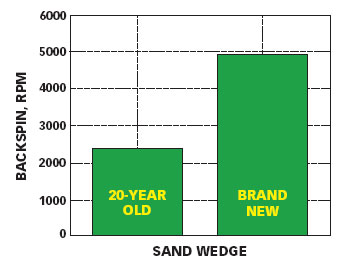

 |
 |
 |
 |
 |
 |
 |
 |
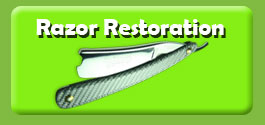 |
 |
 |
 |
 |
 |
 |
 |
 |
 |
 |
 |
 |
 |
 |
 |
 |
 |
 |
 |
 |
 |
 |
 |
 |
 |
 |
 |
 |
 |
 |
 |
 |
 |
 |
 |
 |
 |
 |
 |
 |
Golf Club Sharpening Service 
Golf Club Faces Sharpened
At the Sharpening Shack, we sharpen metal golf club faces. Restoring and re-grooving your 3 iron through sand wedge grooves will help you breathe new life back into your short game, generate massive spin and control just like a PGA golf pro does. Whether you use Ping, Titleist, Mizuno, Taylor Made etc..your grooves will feel and play like new club face.
Do you have to sharpen your clubs? Well truthfully no!!! But if your talent level is not that of Tiger Woods, then something as simple as playing with CLEAN, WELL MAINTAINED equipment will give you the best chance to perform at the top of your game. I know it seems so simple, but think about it; how could you expect to hit a good shot with worn grooves and a dirty club face? Clean your gear, and sharpen those clubs about every 4 to 5 years.
Signs that you need your Pre-2011 irons sharpened:
- Check for a "Halo" Strike Pattern on face of the irons,this is a sure sign of aggressive wear. The image below is an example of severe wear, most clubs just show a bright or different color on the metal wear the ball has been striking.
- Bottom two grooves or channels on face of club look "flat, dull and rounded" then grooves above them.
- Rust in grooves-channels.
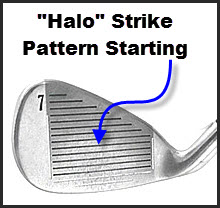 ----
----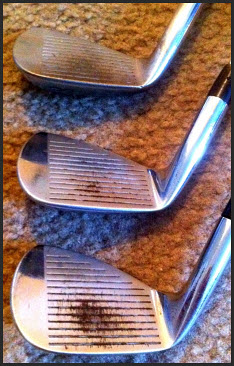
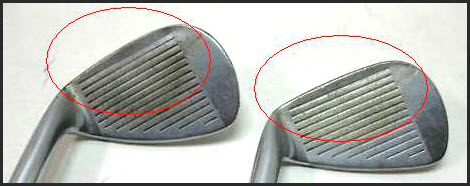
The golf club sharpening service removes bent over metal from the edges, we then sharpen the grooves in clubs that have been worn down or beat up over time to a condition similar to when they were new, its purpose is to redefine the edges,
Important Facts About Golf Club Sharpening Service:
-
It takes time and care to sharpen golf club faces, so please plan on at least a 24 to 48 hour turn-around for sharpening.
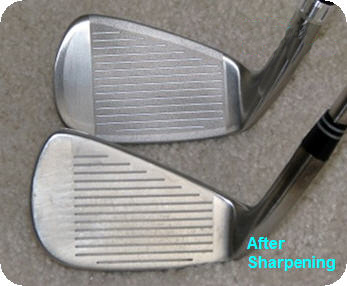 |
Golf Club Sharpening Service Golf Iron Sharpening Services Include:
|
 -------- --------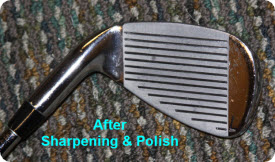 |
|
Note:
|
|
Important Facts About Back-Spinning Golf Balls
Golf.com Groove Test Results: Most golfers change putters and drivers like they do socks. But chances are if you have a sand wedge you like then you've stuck with it for years—it's tough to give one up when you know it works. There's also a good chance that its grooves are practically worn away due to years of ballstriking. Do worn grooves actually hurt your game? Hot Stix Golf, our exclusive research partner, ran the following test to find out. GOLF.COM TEST
FINDINGS NEW PGA Golf Club Groove Rules: Quick, go buy those old pre-2010 irons with U shaped grooves, manufacturers cannot produce anymore of the square-grooved iron sets after the December 31, 2010 !!! Almost all your irons will be affected by this rule. As a player looking to get the most out of your clubs, why would you not give yourself every advantage possible? The truth about the new groove rule is that it will affect all clubs that have more than 24 degrees of loft. That means that every iron, 4-iron through pitching wedge, will be affected by this rule. Just as with wedges, manufacturers also cannot produce anymore of the square-grooved iron sets after the December 31, 2010. So, if you want to take advantage of a great club that you will be able to use for about 14 years, and there is no reason not to, you need to get out and buy soon. The best way to give yourself every opportunity to hit great shots more often, is to go out and buy the best, most user-friendly equipment possible. The clubs affected by this ruling have deeper, sharper grooves that provide more spin, and thus, more control, so it stands to reason that getting these clubs is an easy decision. Don’t let anyone beat you simply because of technology, with these clubs you will be prepared to play your best.
|
|

National City Sharpening Services | Kitchen Knives Sharpened | Restaurant Knife Sharpening | Lopper Sharpening | Axe Sharpening
Mail-Order Sharpening | Ski Sharpening | Lawn Mower Blades Sharpened | Wood Turning Tools Sharpened | Knife Reconditioning
Wholesale Knife Sales | Contact Sharpening Shack | Pick-Up & Delivery Sharpening Service | Paper Cutter Sharpening | Sitemap


